#you can only copyright a pattern. not the objects made from the pattern. it Can be a breach of contract law but the contract
Text
Art theory states that art should have intention. A dissertation on "AI Art".
A disclaimer first of all that I am someone that has dived deep into AI image generation, I've worked with and created my own models and generated my own images using the open source code. I did this to understand what it is and how it works and I'd say I understand it more than most artists that talk about it online. I feel confident saying that I know what I'm talking about in this matter. I know its capabilities and limitations.
I'm not going to get into the morality of the use of it. I won't defend the rampant theft and copyright violations, I'm someone that believes that AI image gen at the very least should never be used for commercial purposes, but in this post I only want to talk about something else: Tte plain and simple merits of AI art as "Art" itself.
I'll start with repeating my premise statement: "Art theory states that art should have intention in order to be art." Does AI generation meet this criteria? Well, no, not really. Specifically it's not an image generation user's "art" if it is art at all.
With pattern biased algorithmic image generation, AKA "AI art”, someone pressing a button after typing in a prompt just doesn’t amount to a person actually picking and choosing their subject, their composition, and ESPECIALLY their meaning and message.
The result is most definitely not the button-pusher's art, the generation is too random and what comes out belongs far more to the machine than to the prompter.
And a machine cannot by itself cogently make the essential choices to make an image successfully have intent. Language models we currently have cannot communicate a person's intent to the machine beyond a few broad strokes tags and trigger words, and pattern bias will often supercede those prompts anyway. A discerning eye will always be able to tell which decisions were made by a machine because it is not making them in the way a human being would, they appear uncanny in the most basic way. The generator is not understanding and interpreting the space and subject in the way that someone who lives and breathes with binocular vision and a human's infinitely more adaptable brain would.
The generator is incapable of truly understanding stylization or design principals, and all its continual, persistent mistakes in numbers of fingers, in anomalous anatomy, and broken gestalt, in nonsensical perspective, and merged and floating objects are a byproduct of this lack of living intelligence. These are things that will never go away, no matter how much data is fed into it because it is flawed at the core by the very basis of its pattern bias. It cannot "learn" how to fix them and so it can only hope to, at best, get lucky enough, or generate enough iterations of the same prompt that the images won't show the cracks. And that process is not creative, it's gambling at a slot machine hoping for a payout.
AI gen really is just a parlor trick at this moment in time, it’s a parrot that’s been taught to repeat phrases in response to certain stimuli to fool you into thinking you’re having a conversation, but it’s just really been trained to recognize noises, not meaning. It's a very pretty bird, but it's no replacement for the real thing, and the longer you "talk" with it, the more obvious that will become.
Art, the real art that the machine is trying and failing to learn from and replicate, requires a human’s creativity and problem solving to be able to make the decisions that will create a piece of art that someone can confidently call their own.
11 notes
·
View notes
Text
A.I. Art is NOT Art!
Recently, artificial intelligence “art” has become increasingly popular. People pay a couple bucks, pop in some pictures of themselves and a computer spits out some fancy images of them. It’s beautiful, and really cool, right? WRONG! Artificial intelligence “art” is not art, nor is it able to be!
On a surface level, artificial intelligence cannot create art simply because art requires creativity. To put it even more simply, the word art is defined in the Merriam-Webster dictionary as “the conscious use of skill and creative imagination especially in the production of aesthetic objects,” and anyone can see through this definition that a computer program cannot create any art that upholds the true definition of art. These programs are not conscious, do not have any sort of skill and, as previously stated, cannot have creativity or imagination. As the name suggests, these programs are artificial, meaning their “ideas” are not real as there is no real thought behind them. The whole goal of art is expressionism through visual factors and by taking the expression out of art, you no longer have proper art!
Secondly, there are many factors surrounding the ethics of these websites and applications. Artificial intelligence works through collecting data, analyzing it, and spitting out whatever result is desired after finding patterns in this data. Now how does this apply in an artistic sense? An A.I. art program collects hundreds of thousands of images online, many of which are copyrighted pieces with hours of work put into them, and essentially collages these pieces together with the images you submit in order to give you a final image. There’s the obvious borderline illegal issue involving copyright and copyright laws, and then there’s the major ethical issue of actual human artists having their work stolen! While copyright laws can be very complicated, the basic information you need to know is that as an artist, you automatically own the copyright to your work so long as it is an original work of art and does not heavily reference an image not taken or made by you. Unlike human artists, an artificial intelligence cannot create an authentic piece of work. It can only take existing works and reuse the existing data it finds. This is incredibly unethical as it leaves many artists without work and with their existing work going uncompensated. Think of it this way, how would you feel if you finished an 8 hour shift at work and your manager informed you that the company was actually unable to pay you your day’s wages? Awful, right? You’d immediately think “that’s illegal!” and that’s because it is! It is illegal to take someone’s time and resources and use them for your own personal gain without compensation. Artificially created “art” programs do exactly this. Seems pretty bad now, right?
Finally, A.I. art is nothing more than another money grab, a capitalistic scheme. You’ve definitely heard of the “starving artist” stereotype before. It’s something I quite commonly hear of as an art student myself. The easiest way to eliminate this stereotype would be to simply pay artists what they’re worth! When it comes to art, you get what you pay for. Art can typically be two of three things: accessible, good, and cheap. If you want accessible and good art, you’ll have to pay an artist, but there’s no guarantee it’ll be cheap. Good and cheap art is typically not something readily accessible, as artists are well aware of the value of their work. Lastly, accessible and cheap art, which in this case I will be associating to A.I. “art”, cannot, will not, and will never be good. Good art comes from hours of work, lots of practice, and a proper, human artist with human creativity. You cannot fabricate that no matter how hard you try.
To conclude, PAY ARTISTS! Artists are real people, these are our real jobs, and our work is being stolen by these programs, which then sell it to you for a low price and with low quality. Artificial intelligence continues to steal jobs, kill creativity, and cater to the capitalistic value of getting things done cheaply and quickly. There’s a lot of value in the work artists do and if you have even a shred of decency, please consider paying an artist friend, relative or acquaintance for your fancy portraits. I can promise you, the work is worth the price and the result will be a beautiful, original and authentic piece that you can truly call your own. Down with the artificial intelligence, artists deserve better!
#ai#artificial intelligence#ai art#ai art generation#ai art is not art#ai art discussion#support artists#pay artists#ai art is theft#ai art community#ai artwork#artists on tumblr#artist#art student#visual arts#digital art#new media
7 notes
·
View notes
Text
Understanding Intellectual Property: An Insightful Overview

In a world where innovation, inventions, and creativity form the backbone of development and progress in business understanding intellectual property Rights is a very important factor. Intellectual property includes innovations, literary and creative works, designs, names, symbols, and pictures utilized in trade. It also includes creations and inventions made by using intelligence. This blog tries to explain what intellectual property is all about and how CCA Legal Firm's experience can help you navigate its complexities.
AN OVERVIEW OF INTELLECTUAL PROPERTY
The cornerstone for defending the rights of people or organizations who produce new works is provided by intellectual property laws. Various types of creative work are protected by these regulations, such as industrial designs, patents, copyrights, trademarks, and geographical indications.
Patents:
An innovation may only be used by the patent holder, who also has the sole right to regulate how others use it. As part of this discussion, the patent owner provides technical details about the innovation in the published patent document.
Three distinct classifications or kinds of patents exist:
Utility Patents: The most prevalent kind of patents are utility patents. These provide new machinery, chemicals, and procedures with protection. A delayed windshield wiper mechanism is one illustration.
Design Patents: A kind of patent that safeguards the distinctive look or style of manufactured goods. The external look, or decorative design, is protected. The original Coca-Cola glass bottle serves as one example.
Plant Patent: A kind of patent that safeguards novel plant varieties, including hybrids, and their asexual reproduction. When a plant reproduces in a manner other than through naturally produced seeds, it is said to be asexual. Using grafting or rooting cuttings, for instance. Take the Irish potato, for instance.
Copyright
This legal phrase refers to the ownership rights that authors and artists have over their creative works, which can include everything from software to technical drawings to novels and music.
In India, copyright law grants the producers of creative content the only authority to use and replicate their creations for the whole lifetime and 60 years after the death of the creator. The copyrighted material enters the public domain when the copyright expires.
Trademarks
Trademarks set one company's products or services apart from another. In the past, artists used a signature or "mark" to identify their goods. By registering a trademark, a business or individual can stop other parties from utilizing their goods or services without authorization. Additionally, they forbid any markings that may be mistaken for already-existing ones. This implies that a company cannot use a symbol or brand name that is identical to one that is already registered especially if the products or services are related or that sounds similar. For example, a soft drink firm cannot lawfully use a name that sounds like Coke or a sign that resembles Coca-Cola.
Industrial Designs
These speak of the decorative or artistic quality of an object, encompassing both two- and three-dimensional elements like hues and patterns.
In general, when such acts are carried out for commercial purposes, the owner of a registered industrial design or of a design patent has the right to prohibit third parties from manufacturing, selling, or importing articles bearing or embodying a design that is a copy, or substantially a copy, of the protected design.
Geographical Indications
These are labels applied to products that have a particular geographical origin and denote attributes unique to that location.
Furthermore, the product's attributes, features, or reputation ought to be primarily attributed to its country of origin. There is an obvious connection between the product and its original location of production since the attributes are dependent on the geographic location of production.
Trade Secrets
Trade secrets are the intellectual property (IP) rights to proprietary knowledge that may be licensed or sold. For knowledge to be considered a trade secret, it must be:
1. Commercially valuable
2. Known to a limited number of people
3. be subject to the reasonable measures made to maintain its secrecy by the information's legitimate owner, such as using confidentiality agreements for associates and staff.
The Role of CCA Legal Firm in Intellectual Property Law
CCA Legal Firm specializes in protecting the rights of those who create innovative works. They offer comprehensive services in various domains of IP law, which are mentioned below as follows:
Patents
The counsels at CCA Legal support patent rights and protection, manage patent applications, oppositions, validity, and infringement advisory, and carry out in-depth prior art searches and freedom to operate analyses.
Copyright
Software program copyrights, assignment, infringement investigation, registration, and the preparation of deeds for copyright transfer and royalties are among the services offered.
Trademark (India and International)
Their knowledge includes internet-based searches for trademarks, submitting and defending trademark applications, registration, renewal, infringement assessment, portfolio administration, and legal disputes.
Key Takeaways
In the age of constant innovation, intellectual property understanding is crucial. It includes a range of rights that safeguard the interests of artists and promote an atmosphere that is conducive to innovation and creativity. The complexity of intellectual property law makes the experience of law companies like CCA Legal Firm vital. Their all-inclusive services guarantee that the rights of inventors and producers are successfully protected, fostering an environment in which ideas may flourish without worrying about being used unfairly.
CONCLUSION
To sum up, intellectual property is an emerging field in this fast-growing world, which plays a critical role in the fields of creativity and innovation. The rights of inventors and creators must be protected, and this requires clear knowledge and use of it. The provision of specialist services by organizations such as CCA Legal Firm makes it easier to navigate the complexity of intellectual property law and guarantees that the creative effort of creators and inventors is duly safeguarded and rewarded.
#intellectual property rights#contract management law services#corporate law#habeas corpus#family law#project consultation#start up law services
1 note
·
View note
Text
MARBLE PATTERN GREEN NORDIC WALL CLOCK WITH 17% OFF: BUY NOW AND PAY LESS
Only in our store and for a limited time can buy the incredible Marble Pattern Green Nordic Wall Clock and save $8.74. Therefore, waste no time - just click on the ADD TO CART button and you’ll get this amazing item with 17% off. Furthermore, when buying this product from us, you also get:
Quality that can't be beat
Expert design
100% buyer satisfaction
Secure shipping
An easy return policy
With our discount, you pay only $41.26 for your choice of Creative Round Print Wall Clock. Buy now, as this offer won't last forever!
SEE MORE DETAILS
Material: Acrylic
Diameter: 30cm
Dimensions: 300mm
Feature: Antique style
Body Material: Plastic
Sounds tempting, doesn’t it? Moreover, it’s your chance to buy this premium quality product at a low price! However, if you don’t believe us, look at the feedback our previous customers left and hurry up to click on ADD TO CART before we’ve sold it out!
PRODUCT QUESTIONS & ANSWERS
Can I get another Color of this item?
You can see all available product variations right in the description of our Marble Pattern Green Nordic Wall Clock, so you’re welcome to choose any!
Which materials does your supplier use in the production of your Creative Round Print Wall Clock?
The quality of resources used when manufacturing our Marble Pattern Green Nordic Wall Clock is as high as required by the industry standards.
Not sure this is affordable.
Please, note that you’re unlikely to find an offer that is as tempting as this one. It’s only up to you to take the decision, but we’d like to remind that the number of goods is limited.
The price seems far too low. Can you explain this?
We’re able to set competitive product prices that make our clients happier because we don’t bear significant stock-related expenses
When I buy something in an online store, I always share my experience in my blog. Is it OK with your goods?
If you want to place the photos of our products on the Internet, you’re free to do so. Certainly, you won’t face any objection on our part.
Is it wise to make this purchase?
Since it is a very tempting offer, we guarantee this purchase will satisfy you!
ORDERING & STORE POLICIES
Do you have the option of a full refund if something bad happens to my package?
You’re more than welcome to contact us, because if we lose or break your package during transfer, you can count on a full refund.
Can I put several products in a single order?
The number of items to include in one order is unlimited, so feel free to order multiple units if you want.
Looks like I made a mistake when placing an order. How can I change the details or cancel the order?
You need to get in touch with our support team and explain your problem to them. They will fix it because they’re always ready to help you out.
I want to ask something, but how do I connect to your help center or something?
You will find the contact details of our support team at the bottom of the page, so feel free to get in touch with our service with any questions about the Marble Pattern Green Nordic Wall Clock.
To clarify, do you sell these legally?
You shouldn’t worry about it. When selling these products, we certainly do not break any Copyright laws.
Can you prove your store is reliable?
We encourage you to check out the feedback that our buyers have left on this and other product pages. We are very open about our business practice, and you can see it with your own eyes!
https://just6f.com/marble-pattern-green-nordic-wall-clock-living-room-decorative-clock-minimalist-art-home-decor-creative-round-print-wall-clock/?feed_id=5512&_unique_id=64d8ad5c4671b
0 notes
Text
Do you ever see something and think ‘wow, I’m a people-pleaser, but not that much’
#i lurk on r/craftsnark because it’s surprisingly entertaining and it seems like every other week they have the debate#about whether it’s okay to sell something you knitted from a pattern#like say if you bought a hat pattern from somebody and made a ton of hats based on said pattern. is it okay to sell those knitted hats#the thing is that all of it is a moot point imo because regardless of what you think about it ethically; it is legal#you can only copyright a pattern. not the objects made from the pattern. it Can be a breach of contract law but the contract#has to be proven#anyway so with all this in mind; this week there was this thread where someone had been messaged by a designer#who was like ‘hey can you stop selling things made from [x pattern] that’s against my terms of use’#and literally they were way too civil about it#i consider myself to be a doormat but i still would’ve been like ‘i’m not going to stop. if you can find a law to sue me under#we can settle this in court. until then good luck getting the stick out of your arse’ and then i would’ve blocked them#i mean can you imagine this happening in any other field? if i look up.. idk… a list of instructions on how to build a desk#and then i decide i want to sell the desk i made.. is the writer of the instructions going to be in my inbox? i highly doubt it#do the people who make art tutorials sue anybody whose art gets better based on their directions?#did blake snyder sue everybody who used a save the cat beat sheet to plan their novel????#maybe not the same exact thing but it is some ridiculous shit. it’s one of those ‘debates’ i’m just sick of seeing#because the answer is so obviously ‘just do it’#it’s legal and how can it possibly be morally wrong. you’re taking nothing away from the designer. no one who wants a hat#is going to buy a piece of paper instead. it’s two separate markets#i’m sick of even talking about it. thanks for reading this nonsense if you did#personal
0 notes
Text
The Bunad: roots of a nationalist symbol
The bunad is a Norwegian folk costume which exists in many regional varieties. A symbol of rootedness and belonging both local and national, the bunad is ubiquituous on Constitution Day, 17 May, but it is also used at other festive occasions. Although it is far more widespread among women than men, male bunads have become common in some social circles.
Can anyone wear a bunad? Is it a real bunad if it is made in China? Is it a symbol of origin and roots or a nationalistic symbol?

It is estimated that Norwegians own altogether 2.5 million bunads, worth more than 40 billion kroner (€500 million). In other words, one in two citizens owns a bunad, and they are expensive garments with embroideries and filigree silver ornaments, consisting of several components often including aprons, headdresses, scarves or shawls. You could easily buy a few prestigious and beautiful dresses from famous designers for the cost of a single bunad. Moreover, bunad ownership and use has grown fast in the last few decades.
The increased popularity of bunads could be put down to the growing prosperity of the population of oil-rich Norway in general. But this is hardly the whole story. A symbol of Norwegianness, rootedness and regional origins, wearing a bunad is a statement about identity. Non-Norwegians are often puzzled by its widespread use, since folk dresses are associated with minorities in other parts of Europe. Perhaps the Norwegian identity is essentially a minority identity, even though independence was achieved through a bloodless secession from the Swedish–Norwegian union in 1905.

The ongoing story of the bunad is complex and involves claims and counter-claims about authenticity, the feared and respected ‘bunad police’ and a vivid popular discourse about who has the moral right to wear which bunad. The right not to wear a bunad is generally tolerated, but there is no strong and visible cosmopolitan discourse dismissing the widespread love of folk costumes as antediluvian, reactionary, nationalist and possibly racist. Yet there is no consensus concerning which dresses should be classified as sufficiently authentic and what the criteria are and it has led to controversies.
The bunad is a particular kind of festive dress. The term is a neologism based on an archaic dialect word, introduced in urban circles by the author and nationalist activist Hulda Garborg in her pamphlet Norsk klædebunad in 1903. Writing during a feverish phase of Norwegian nationalism just ahead of independence, Garborg argued the need for a truly Norwegian and regional form of formal dress. She collected and systematised what she saw as intact and useful regional bunad traditions, and even designed some bunads herself. Interestingly, Garborg never denied the syncretic and partly invented character of the new, traditionalist folk costume. She nevertheless emphasised its role as a marker of rural, Norwegian identity.

A relevant distinction can be drawn between a bunad and a folk costume. Folk costumes are everyday and festive clothes which were traditionally worn by peasants in southern Norway, and – like certain kinds of peasant food – have been recontextualised and upgraded more recently as formal dress. Bunads, on the contrary, are reconstructed and re-designed – sometimes very nearly purely invented – costumes designed from the early 20th century onwards, and are used at occasions such as Christmas Eve, Constitution Day, weddings and other major social events, although not at funerals: bunads are bright and joyful garments. Some bunads represent minor adjustments (‘upgradings’ and modernisations) of the original folk costume, while the link is less obvious or absent in other cases.
The bunad is an important traditionalist symbol of modern Norwegianness. Most of these costumes are related to regional and minority folk costumes from Central and Eastern Europe, and the German influence has often been commented upon. More importantly, the bunad confirms Norwegian identity as an essentially rural one, where personal integrity is linked to roots and regional origins. However, 18th and 19th century peasants would often wear European-style dress at formal occasions such as weddings, or they might wear a folk costume, which gradually went out of use. In other words, there is a clear element of modern invention, which nobody denies, not only in the currently widespread use of bunads, but also in their design.

What exactly, then, is a bunad? One possible answer widely accepted is: a festive dress associated with a regional Norwegian tradition, accepted by the Bunad and Folk Costume Council as such, and widely recognised as a bunad by the public. Its popularity as a symbol of tradition has increased proportionally with the modernisation and urbanisation of Norway in the last hundred years, thereby saying something essential about the politics and poetics of identity in modern societies, where the quest for rootedness in the past increases with de facto uprootedness.
In contemporary society, many if not most individuals have two, three or four options: they can legitimately wear a bunad designed in the place where they live, in the place where they grew up, or in one of their parents’ places of origin. They cannot, however, legitimately wear a bunad from wherever they fancy. Of course, they could buy it, but their friends and relatives might frown.
Norwegians who live in the heart of urban cities and have no real rural roots are sometimes unaware of people in the heart of Bunad Norway who are deeply offended. These rural Norwegians as they see it have no time for West End ladies who claim Telemark ancestry when they buy the perhaps greatest status symbol of all bunads, namely the expensive and exclusive East Telemark bunad. They also disapprove of people wearing gold chains and earrings with their bunads.

There are frequent conflicts over authenticity framed within the bunad discourse itself. In the valley of Numedal, competition between two alternative bunads actually led to the creation of two distinct factions in the 17 May parade of 2002. Family members fell out with each other; local politicians groped for compromises. One of the alternatives, a simple folk costume, is woven in dark fabrics; the complex, reconstructed bunad sanctioned by the Bunad and Folk Costume Council is much more elaborate and colourful. The defenders of the simple costume argue that the new one, ‘overloaded with silver and embroideries’, is inappropriate and clearly inauthentic for a traditionally poor mountain valley; while the other faction see the simple bunad as sordid and joyless. Both factions claimed that their bunad was the most ancient one. The colourful and expensive alternative won in the end.
The bunad stirs up strong emotions. After the 17 May celebrations in 2001, Queen Sonja was criticised in public for wearing sunglasses with her bunad; in the same year, Crown Princess Mette-Marit was severely reprimanded in the press for wearing a purely invented ‘fantasy costume’ rather than an authentic bunad from her home region. She has since made amends, and now has several bunads to choose between (legitimate in her case, being princess of the whole realm), including an elaborate bunad from her home county of Vest-Agder in the far south of the country. Women are generally advised by the Bunad and Folk Costume Council not to wear makeup and earrings with their bunad.

Because of the wealth of detail, a proper bunad cannot be made industrially in its entirety. This partly accounts for its high market price. Moreover, the knowledge and skill required to make a bunad is considered a cultural, local form of knowledge – a kind of inalienable possession. In the spring of 2002, a conflict erupted between the traditionalists and a young entrepreneur who wanted a slice of the market. This conflict inadvertently brought the implicit ideology underlying the bunad to the public eye. The controversy is still alive today, with cultural arguments overlapping with the economic ones.
What happened was this. A young Norwegian of Chinese origin, who originally worked as a cook, began to take an interest in bunads. He took a bunad course, learning the basics of the craft. Before going into business, he changed his name from Aching to John Helge Dahl, realising that he would have little credibility as a bunad salesman with a Chinese name. (The current owner of the company founded by Dahl is nevertheless called You Hong Bei.)
Dahl founded a company called ‘Norske Bunader’ (Norwegian bunads), and then he did the outrageous thing, namely to contract dozens of Chinese seamstresses in Shanghai to do the stitching and embroidery. The fabrics were sent from Norway, and the completed garments were returned – at a much lower price than that of the Norwegian competition. He built the bunads himself. ‘To most people, it is the quality that counts,’ he says, ‘not who has done the embroidery’. Of course, he can offer bunads at a competitive price.

The Bunad and Folk Costume Council reacted strongly against Mr. Dahl, as did Husfliden. At one point the latter threatened to sue him for plagiarism, but since bunad designs are not copyrighted, they were likely to lose a court case. Their argument was that the craft amounted to a locally embedded kind of knowledge which did not travel well, comparing it to dialects. Talking about mass production and industrialisation of bunad production, they argued that the use of foreign labour leads to cultural flattening. The resulting products were said to have no hau, to use the anthropologist Marcel Mauss’s term for the ‘soul’ of an object.
Opinions bitterly divided people. Many who defended the traditionalists said that this concerns ‘personal knowledge’. Bunad embroidery was a kind of handwriting. They argued that when anyone can take a pattern, send it abroad, and make a good profit from the product, people will ask: ‘What is it that I am spending one or two months’ salary on?’ Many argued that this kind of garment would feel alienating, and that it would not satisfy people’s emotional need to build their own history into the garment.
Another argument concerns the low salaries in China, claiming that it was immoral to hire ‘underpaid women’ to do this kind of work. Dahl’s Shanghai seamstresses were paid what he described as a good salary in China, but which is a fraction of a comparable Norwegian salary. Yet others have said that it may be acceptable to employ immigrant women living in Norway, who may have assimilated some local skills, but not to employ foreign women living abroad.

Although the Dahl case was spectacular in that it simultaneously brought out both accusations of racism and controversy concerning criteria for authenticity, his business innovation was less original than it might seem. Several producers admit that they outsource parts of their production to the Baltic countries and elsewhere where wages are low, and even Husfliden has admitted that parts of their bunads are made industrially because of the high cost of labour in Norway.
The anxieties voiced by the critics of the outsourcing of bunad production are threefold: In a thoroughly neo-liberal society (anyone can wear what she wants; anyone can design and make bunads anywhere in the world), national identity suffers because regional roots are severed; economic interests suffer because prices go down; and the personal or emotional pole of the user suffers since the garments lose their special quality.
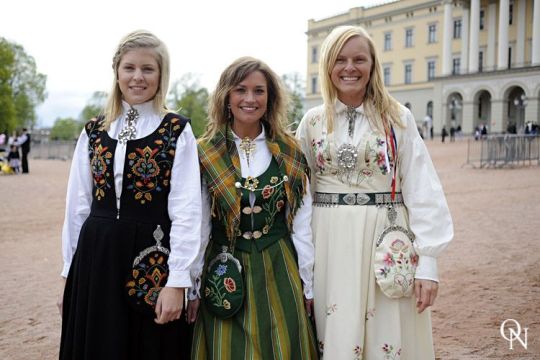
In what exactly does this ‘special quality’ consist? What is the nature of the considerable personal capital invested into clothes?
What is reaped from this investment is a handsome profit, an enhanced sense of community and visible boundaries to the outside world. Cultural property of this kind is intangible, it is legally oblique, and it is poised to lose against both the brisk efficiency of contemporary capitalism and against the individualism of free choice.
So the main question as I see it: is what price your heritage?
Put your secret/sacred knowledge online, and the spell is immediately broken.
This kind of knowledge has to be scarce, localised and difficult to obtain, or it loses its magic qualities. Beyond pricing policies and profits, this is what stirs the souls of the people who care about the national and regional provenance of their bunad. Had they chosen a Dior dress instead, or a pair of blue jeans and a nice T-shirt, the problem would not have arisen.

Still critics argue why all the fuss? The Bunad is no different from what a kilt is to a Scotsman or a lederhosen is to the Bavarian or a sari is to an Indian. Yes and no. Each of these have differing degrees of exclusivity and symbology.
The kilt arguably was an English invention to control the Highland clans. But it became something else - a national symbol of being loyal to clan, crown and country. It used to be people only wore kilts if they had a hereditary claim to that tartan but nowadays no one really cares what tartan you wear (much to the chagrin of older generations). The lederhosen has always been a regional symbol not a national one but has been ‘McDonalised’ to an Oktoberfest fancy dress costume party. The sari is an interesting example that remains a distinctly Indian national symbol but can also now be readily worn by anyone around the world - just as well as I love wearing saris at Indian weddings and when I lived in India. But the Bunad is different because of its own distinct roots that has never left its national borders. The Bunad is a living tapestry and its threads can’t be simply out sourced to other countries.
One’s heritage should never be outsourced. To the anti-traditionalist naysayers I would say that the bunad is a special kind of garment saturated with symbolism and existential significance; it is from somewhere, not from anywhere. It’s Norwegian, born and bred.
226 notes
·
View notes
Text
Queen of My Heart ; Draco Malfoy

summary: draco’s always loved watching you do your hair.
prompt: "until that day, you know you are the queen of my heart.”
requested? “ would you be open to doing a draco x black fem reader where they have a kid and she’s teaching how to do their hair :) and then draco can’t help but to boast that he did their hair everytime his family or someone compliments it :) “
pairings: draco malfoy/reader
warnings: n/a, pure fluff
notes: black!female!reader
Copyright Disclaimer under section 107 of the Copyright Act of 1976, allowance is made for “fair use” for purposes such as criticism, comment, news reporting, teaching, scholarship, education and research, thereby I do not own the rights to any of the characters shown in the below writing.
Draco had always loved watching you do your hair. The first time he’d met you, he’d been absolutely enamored. He’d seen people of colour before of course, he wasn’t surprised by that, but by the simple and yet elegant way your hair was done. He’d quickly befriended you and he’d always been very respectful, had been willing to listen to you complain about your struggles, how it always took ages to do your hair, how social prejudice held you back from doing the things you love even as a child, and how dehumanizing it was for random people to come up and ask you if they could touch your hair.
He remembered your words clearly, it was fourth year, shortly before you’d begun dating; “I hate it, Draco. I get it, they like my hair, but for years I’ve been treated differently for it and I just want it to stop. It’s like they treat me like a dog, like they can just come up and ask my owner if they can pet me. I’m not an animal, for merlin’s sake.” she’d ranted, head laying in his lap as his hand stroked her arm, thumb rubbing in circular patterns. Back then he’d thanked the heavens that he’d never asked that, he’d never want to make you feel like that.
Maybe that’s why it didn’t shock him when he’d lashed out that one time in fourth year when everyone was putting their names in the goblet, one of the durmstrang boys had been walking confidently down the aisle, trying to subtly edge around him to get to the goblet, and had pat your hair and winked at you in passing. Maybe the boy had thought he was being kind, but Draco had watched your face fall and your hands clasp in your eyes, and within seconds his fist had flew forward and, with a mighty crack, he’d broken the boy’s nose.
he’d got detention for to weeks for physical assault, but he’d never felt sorry for what he’d done. When asked by Dumbledore in his office to apologize, he’d refused. He remembered your look of awe as he spoke; “With all due respect, I’m not going to apologize for something I’m not sorry for, Professor.”
You kissed him after you’d both left the office, knocked the wind right out of him in fact, and gained yourself an evening’s detention from Snape for indecent behavior and public displays of affection.
These days it was both the same and different. You have a son and a daughter, Scorpius and Cassiopeia, Cass for short. Scorpius took after his father for the most part, his skin an orange-brown, almost tawny in shade, though his hair was the same as yours; cloudy, luxurious umber curls. He has his father’s eyes, however; a striking, icy blue-grey. Cass, though, at the age of seven wasn’t particularly satisfied with her hair. She went to a normal wizarding primary school, though she’d quickly noticed how her hair was much different from the others, how her skin was much different too.
The first time she’d questioned her father about it, you could swear he had a heart attack. Draco wasn’t the most skilled on 4C hair, in any departments, whether it was actually doing it or just knowing about it. That being said, he’d tried to use you as an example of how beautiful her natural hair was, only for you to walk through the door wearing a weave. To say he felt like crap in that moment was an understatement.
After she’d walked off to her room, her shoulders down and her feet dragging dejectedly, he’d explained everything to you. The next day, Draco took Scorpius to get his hair done; he’d come back with a fade and finger-waves, and your daughter had loved it. Scorpius had too, but he was much less vocal about it; he went to school with Blaise’s son, and he’d made friends with Dean Thomas’s daughter, too, and he was also just on a whole not as bothered about hair.
Your daughter, though, couldn’t stop gushing. She’d tug on her father’s hand incessantly, eyes wide and bright as ever while her lips pulled into the widest smile he’d seen her wear in weeks, and asked if he could do her hair. He agreed, he’d never been able to refuse the true queen of his heart; only to have to get you to show him how to do it on your own head the same night. You were exhausted the next day, it took some time to teach him and the tugging at your scalp from both of you had left your head sore, and Draco was equally as tired, and so the day after that he’d sat your daughter down in front of your dressing table and he’d done her hair.
The style they had decided on was crochet braids. The day before, you’d gone out and bought the bundles even as tired as you were, and today he set to work.
It took hours, as Draco wasn’t the most experienced. They took plenty of breaks when his back began to hurt, or when her neck began to hurt, or her head or his fingers, but they got it done.
And oh, didn’t she look beautiful.
Your husband had done his best to achieve the look she wanted, and while not the neatest, he’d kept going until he got it right. He’d tried his very best, and she looked amazing. To you, you could see how some of the curls had gotten loose with all the fiddling, how some of the braids weren’t as tight as they would have been if you’d done it, but you were so very proud of him anyway.
Cass insisted on calling her friends, Lily and Rose and their brothers over to show them her hair. You’d tried to compromise with sending pictures to their parents, knowing how Draco hadn’t been the best of friends with their parents during school, but she’d insisted, and Draco had always been soft for his daughter. Scorpius had managed to wrangle you into calling Blaise and Dean over too, and by extension Seamus and Neville, and with Ron, Hermione, Harry and Ginny came George and Luna, too.
To say the manor was full that day was an understatement. Lucius and Narcissa still stayed with you, though Draco’s grandfather had died while you were still at school, and Narcissa had insisted on Andromeda and Teddy coming too. You didn’t object, only watched all of the children play with Draco and Dean, dogpiling the two adults while joyful laughter filled the air. You sipped your tea and hummed, smiling as Draco eventually escaped and made his way towards your.
When Hermione turned to you with a wide grin on her face and laid her hand on your shoulder, you paused at her words, allowing Draco to speak. You watched with barely concealed pride as her eyes widened in surprise, and she began to giggle along with Harry and Ron, and Blaise jabbed at your husbands ribs in jest.
“Oh, don’t go complimenting her like that, Granger. That was all me.”
You could never be prouder.
#draco malfoy x reader#draco malfoy imagines#draco malfoy fanfiction#scorpius malfoy#poc reader#female reader#black reader#fluff#draco malfoy fluff#this is softttt
58 notes
·
View notes
Text
Screaming into the Void
I write for half an hour almost every morning. Not fiction. More like a transcription of the conversations I have with myself trying to untangle whatever pressing thoughts kept me up that night. I do this because I’ve learned the hard way that people don’t want to hear what’s in my head. Or at least the ones I talk to are tired of hearing it. Unfortunately talking about it makes me feel better. It helps me process and make sense of this absurd world we all live in. So I write instead.
If I could afford a therapist I’m pretty sure she would say that’s a good thing. Healthy coping mechanism. Therapists like it when people write about their thoughts. Journaling helps get ideas out, forces you to slow down enough to actually think about them, and being written down can help you remember it later. I get that. Journaling really is good therapy and I recommend it for everyone.
I just find it hard to understand why people don’t like talking about the things in my journal. But then I also don’t understand why people do most of what they do. I am Autistic so I don’t really get “normal” things.
“I’ve spent a lifetime being told to shut up”
My journal isn’t normal either. It’s not full of hopes, dreams, or even nightmares. It rarely talks about myself or my day and then only to exemplify a broader subject. Its entries are not addressed “Dear Diary” or to my future self or even some imaginary friend. The intended audience is most often all of humanity, or at least America. It reads like a collection of academic papers or editorials on a wide range of topics. I often end up doing research for these articles, as if they might someday be published in a very strange magazine.
But they never will be. I’ve been convinced that no one wants to hear what I’m trying to say. I’ve spent a lifetime being told to shut up about it. Stop being so paranoid/alarmist/negative. It’s rude to point that out. Or my favorite - No one cares about that. So I go through life observing patterns, taking note of things that normal people are too busy or afraid to see. And I do nothing with it.
Part of me hates that. The part that hasn’t given up yet. I really think it could do some good if people would just listen to what I have to say once in a while. Not that any of it is revolutionary. I’m no genius. It’s probably all been said a dozen times by people smarter than me. But good ideas bear repeating and it wouldn’t hurt to hear them again. Especially with all the bad ideas going around these days.
“Does anyone out there want to listen?”
This will probably go nowhere. I’m just screaming into the void after all. But I wonder - does anyone out there want to listen? So I’m writing today, for a lot more than half an hour, to ask anyone who sees this if they want to read my journal. Most of it’s not even finished. I usually give up once the crushing reality that no one cares starts to outweigh my need for connection. But if anyone is interested I will gladly finish whatever article they would like to read and publish it here for the world to see.
Pick an Article and I’ll Post It:
2020: Vindication for Losing My Mind in 2016
How to Find Meaning in a World That Doesn’t Make Sense
Apparently Making Everyone Live My Lifestyle Collapses the Economy
Workplace Inequality: I’ve Hit the Autistic Glass Ceiling
The Importance of Art in Civilization: Unifying Self Expression
How to Make CBD at Home and Why it May not be Legal
The Pandemic Showed Me How Stressful Being Normal Really Is
I Hated Social Media Before it Was Cool
Generational Poverty: the Engine of Systemic Racism
Sorry State of Women’s Health: Endometriosis Sucks
Historiography of the End of Civilization: from Sumeria to Us
How to Fix American Schools: Respect Different Intelligences
How Branding Made Zoom a Household Name though Discord is Objectively Better
When Were We Great? History of American Exceptionalism
Aquaponics: Making Fish Feed the World
That’s the Way it Is: Abuse, Neglect, and ASD
Copyright Paradox: Supporting Artists while Stifling Creativity
How to Fix Capitalism: Recipes for Eating the Rich
The Relationship Cycle: Why I Can’t Keep Friends
American Politics: Eerily Similar to Divorced Parents
My Father the Man-child: Growing up with a Narcissist
The World Would be a Better Place if Liberals Understood Branding
Body Hair Positivity: Good or Gross?
Rose Colored Glasses Prevent Migraines - Not a Metaphor
OK Boomer: Explaining to My Parents How Much Easier They Have It
When Fanworks Were Mainstream and How That Changed
What’s Wrong with Academia and How to Fix It
Being Moderate in America: So I’m a Liberal Now?
Conservative Hypocrisy: Quantity over Quality of Life
Liberal Idiocy: Being Right Doesn’t Win the Fight
Conservative Hypocrisy: Law and Order not Protect and Serve
Liberal Idiocy: It’s Hard to be Woke When You’re Poor
Conservative Hypocrisy: What Would Jesus Really Say about America?
Liberal Idiocy: Slactivism’s False Sense of Accomplishment
Conservative Hypocrisy: How to Sneak Facism into a Democracy
Liberal Idiocy: One Size Does Not Fit All
Conservative Idiocy: Private Gun Owner vs the US Military
Liberal Hypocrisy: Social Justice Warriors
Perceived Reality: We Really Do Live in Different Worlds
Standing Still: Paralyzed by Emotional Shutdown
American Sheeple: Generations of Domestication
Depression. It’s a Lifestyle.
How to Survive in a World That Doesn’t Want You
Leave a comment to let me know what you'd like to read. If anything.
13 notes
·
View notes
Text
Geometry Club

©Dave Mullan

©Adrian flickr
“Embrace nature’s brutal perfection” Boyd Rice
Research the Narrative
The research required for this brief is simply to gather inspirational images from other practitioners. Add this to your blog/workbook with clear information as to where the images were sourced and who the copyright belongs to.
Tell the Story
Shape and form in environmental photography underpins the overall aesthetic, considering the underlaying composition of an image allows the photographer to explore the subject in new and exciting ways and help you see the photograph as a unique representation of the subject you choose.
Simple geometry can be found everywhere, the shapes formed by the play of light, structures intertwining, objects passing each other… training your eye to look out for strong shape to compose your subject is an important part of constructing strong, bold photographs. Waiting for the correct moment to press the shutter release is a skill in finding the right moment.
Look around your environment to find strong geometric images. Shoot 100 photographs with the main focus being on strong geometric shape, within an outdoor environment.
Edit and refine: Complete worksheet
Make a contact sheet of the best images.
Study and ‘mark-up’ the contact sheet, making aesthetic decisions on your final selection.
Optimise your best TEN images Describe your decision-making process.
Submit: Series of TEN images on ONE A3 canvas 300ppi. Upload to my city.
Geometry Club Research
What Makes a Great Fine Art Architectural Photograph?
JUNE 22, 2018 · SHARON TENENBAUM
Every person you ask might have a different answer to the question, what makes a great fine art architectural photograph? However, in my experience, there are a few key factors that are necessary for transforming a good image into a great one.
Great architectural images often follow these 3 features:
· Composition. In architectural photography, you need to use the language of geometric lines and shapes. These elements must create a harmonious balance within your frame. Without this component, not much can be done to salvage an image.
· Simplicity. Once the shot is made, ask yourself: “What elements in the image are not adding to the story?” In other words, try to simplify your scene by eliminating unnecessary details.
· Post-processing. Once the two factors above are covered, the work on post-processing begins. If you are familiar with my work, you might be aware that I’m a strong advocate of ‘creating’ an image and not ‘capturing’ one. This means accentuating and exaggerating the compositional elements mentioned above, and creating depth, volume, and balance through selective lighting.
Image 1 – BEFORE: cluttered, unprocessed and without a person in the frame. Even though the compositional foundation is present, there is still much work to be done on decluttering and gradient lighting.

Image 2 – AFTER: ‘cleaning’ the image of unnecessary details and implementing gradient lighting.

Until recently, this is where my creative process stopped. I don’t want to elaborate too much on the features listed above; instead, I want to talk about an element in architectural photography which I’ve only lately begun exploring.
Creative Shift
As architectural fine art photography is my passion, it’s been the subject of my images for over a decade now. My path of creating this body of work was a path of self-discovery. Even though some of my earlier architectural images are stellar and I would not have done anything different with them today, in my newer work, I am embarking on a creative shift. This shift is taking my architectural images in a different direction, so now, they are not just about celebrating form, but also about human interaction with the architectural environment.
Architectural structures, by their nature, are designed to serve a purpose for people. By eliminating people out of the composition, the photographer is celebrating the art of geometry and engineering above anything else. As magnificent as the design might be, by including a human element in the composition, the image takes on a new (and different) life form. The benefits are three-fold:
First, it adds a sense of life and warmth to an otherwise cool scene. An architectural image is naturally cold, comprised of concrete, steel and/or wood. By including even a single person in the image, we are warming up the scene and crossing the boundaries from the inanimate to the animate.
Second, it gives a structure a sense of scale and comes closer to the architect’s original intent in design, which is serving people for a specific purpose. For instance, Middle Age Gothic churches were designed to dwarf the scale of a human in comparison to the House of God they were entering. A church was designed to be of an enormous scale to give the parishioners an ‘otherworldly’ experience. If you walked into a Middle Age church and did not get that feeling, then the architect did not do his job right. This was done with the intention of making one feel small in the presence of the Almighty God. Likewise, an image of a church that depicts the sense of scale by including a human reference would convey that concept whereas the image without one would not.
Lastly, by adding a single person, we are giving the viewer’s eye a resting point. The psychological reason for this I can’t say, but it’s a fact. We tend to first spot the person in the image and use the rest as a background. That makes the image more intriguing on a few levels. First, as the photographer/artist, you now have the power to direct the attention of your viewers. You are saying to them: “Start here.” Second, it helps to simplify a scene that otherwise can be too busy with lines and shapes (as in the image below). Third, and maybe most important, it adds asymmetry or shifts the ‘center of gravity’ of an image to create a more intriguing composition.
Looking at the image below, we can see all the points I stated above exemplified, as the image without the cyclist is lacking warmth, a sense of scale and a resting point.
Image 1: With Cyclist

Image 2: Without Cyclist

Sharon Tenenbaum teaches Fine Art Architectural Photography Workshops around the world. To learn more about Sharon’s work and details about her upcoming workshops, please visit: SharonTenenbaum.com
Source: https://www.thephotoargus.com/what-makes-a-great-fine-art-architectural-photograph/
Matthias Heiderich
A self-taught photographer, Matthias Heiderich (b. 1982) explores urban environments, finding surprising angles and colours within cityscapes. His shots are framed in a distinct way, focusing on corners, sides and small sections of buildings. Consequently, he does not just record what he sees; rather he transforms the ordinary into dream-like spaces that suggest a futuristic universe. The minimalist images bring attention to symmetry, lines and patterns prevalent in the urban landscape. Primarily working in the realm of fine art, his pieces have also appeared in architecture and travel publications, such as Wallpaper* and Cereal. Since 2011, Heiderich’s images have been exhibited at galleries in Berlin, Barcelona, San Francisco, St Petersburg and Zürich. In 2014 Spektrum Berlin was published with the Parisian publisher Editions Intervalles. The images selected are an overview, illustrating how exploring lines, structures and space rejects the banality of city scenes, reforming them into an awe-inspiring collage of geometric shapes. www.matthias-heiderich.de.









Source: https://aestheticamagazine.com/geometric-architecture/
Architecture photography corner – in pictures
In 2014, Sheffield-based photographer and graphic designer Dave Mullen Jr started Geometry Club, a collaborative Instagram project in which people submit images of buildings forming carefully composed triangle shapes. Mullen is now creating an app to simplify the meticulous formatting process, and says the project is “a test of building an audience based on curating the same thing”. The account has attracted more than 25,000 followers and welcomes contributions by professional and amateur photographers. “I quite like the fact that sometimes you look at the photos and it’s not obvious that it’s architecture straight away,” says Mullen.
Photograph by @grg_mlll (US).

Photograph by @ferrypasschier (Netherlands).

Photograph by @mismaria (England).

Photograph by @davemullenjnr (England).

Photograph by @jagamac266 (Singapore).

Photograph by @marcclish (Scotland).

Source: https://www.theguardian.com/artanddesign/gallery/2017/jan/28/architecture-photography-corner-in-pictures
7 Tips to Spice up Your Photography Using Geometry
MARCO DE GROOT
October 9, 2017
Finding yourself in a photographic rut? Add value to your images by keeping these geometric principles in mind.
SYMMETRY
Symmetry lies at the heart of the laws of nature. It’s calming and pleasant to the eye when an image features a symmetrical composition. But a photo doesn’t necessarily need to be split directly down the middle to successfully incorporate symmetry. When an image feels balanced, you can achieve the same (and sometimes more interesting) result.
Look around on your next trip; you can find symmetry everywhere.



SHAPES
Using shapes is another way to creatively frame the subjects in your photos.
Squares and rectangles suggest conformity and order. Keep an eye out for these shapes and use them to enhance that feeling.


On the other hand, the circle represents unity, completion, and perfection. When used in an image, circular shapes can help draw the eye inward and keep the viewer’s attention on the subject.


Finally, triangles are a good way to focus attention toward a certain point. And, depending on the way a triangle is angled, it can evoke a calm or energetic feeling for the viewer.


CONVERGING LINES
Converging lines can be used to add depth and guide the viewer’s attention in a specific direction. These lines don’t need to be physical, per se, but can be created using a pattern that directs the gaze forward.


PARALLEL LINES
The use of parallel lines evokes order and rhythm in photography. Parallel vertical lines give the illusion of growth, while horizontal lines give the impression of calmness or tranquility.


INTERSECTING LINES
Diagonal or angled leading lines can make an image seem more dynamic. By highlighting these lines, photos become more active. Depending on your angle, intersecting leading lines can also help connect more than one subject or add depth to a photo.


PATTERNS
Patterns are a useful tool for both framing and composition in photography. When a frame is filled with shapes it can add to a photo’s drama or, when aligned, its order.
You can find patterns in window arrangements in buildings, shapes of tiles, pebbles on a beach, bricks on a wall etc.. When you know what to look for, you can find them all around you.


PERSPECTIVE
Sometimes, even a perfectly-composed shot can end up looking a bit boring. If that’s the case, try changing the perspective by flipping or rotating the image to find the view that makes it most intriguing.



Source: https://passionpassport.com/spice-up-your-photography-with-geometry/
Shoot 1 Contact Sheets


Contact sheets marked up with images chosen for optimisation

I feel the above selected images could work well when optimised as they contain strong and repeating geometric patterns. The images are high contrast and colourful, while the ones chosen from the contact sheet below contain intricate patterns in the shadows created by the strong sunlight.

Most successful optimised images from shoot





Marked up contact sheet from 2nd shoot

Most successful optimised images from shoot






1 note
·
View note
Text
📜 Legal Notices
This copy is allowed to be used for personal and/or small-time commercial purposes with visible, explicit credit that has a working link back to this blog.
⚠️🗣 Opinion Disclaimer
Views, thoughts, and opinions expressed in this blog belong solely to the author. All opinions on this blog are purely personal and not to be taken as fact. No commentary, slander, or defamation of character is intended towards members of BTS. The content is made to serve as a means of self-expression.
⚠️💫 Astrology Disclaimer
Astrology should not be taken as fact. It is a system that guides us towards themes that are possibly relevant to an individual’s life. It is a tool that serves as a layer through which we perceive and develop.
No commentary, disrespect, slander, or defamation of character is intended towards members of BTS at all. Care is taken to make a distinction between Canon!BTS and Astro!BTS. Content is made to serve as a means of entertainment and self-growth. With regard to private entities not in the public eye, any resemblance to actual persons, living or dead, or actual events is purely coincidental with no intent to expose.
⚠️📚 Fiction Disclaimer
All original content is a work of fiction for entertainment purposes only. Names, characters, businesses, places, events, locales, and incidents are inspired by and/or borrowed from the public entertainment personas of BTS members solely for use in a fictitious manner.
No commentary, disrespect, slander, or defamation of character is intended towards members of BTS at all. Care is taken to make a distinction between Canon!BTS and Fic!BTS. Content is made to serve as a means of introspection and self-growth. With regard to private entities not in the public eye, any resemblance to actual persons, living or dead, or actual events is purely coincidental with no intent to expose.
⚠️🔮 Tarot Disclaimer
Tarot interpretation is personal, intuitive and nuanced. It is not to be taken as fact. The cards are a system of ‘divination,’ i.e., inference, based on the yet unproven concept that everything in the universe has a vibrational signature and that these vibrations obey the universal law of like attracting like. Tarot readings only hold true for the present based on current circumstances because energies are constantly in flux and free will exists. It offers a glimpse of some perspectives from several that are all true, it points along a possible future from many.
Many tarot readers have likely made posts on the same topics I have and their readings might be completely different or the same as mine. Through experience, I’ve learned that readings aren’t mutually exclusive but rather build on each other. Tarot posts usually address only a couple of questions and that gives us a very small slice of the big picture. Patterns become clearer and themes emerge when we have a volume of readings to draw from.
No commentary, disrespect, slander, or defamation of character is intended towards members of BTS at all. Care is taken to make a distinction between Canon!BTS and Tarot!BTS. Content is made to serve as a means of entertainment, introspection, and self-growth. With regard to private entities not in the public eye, any resemblance to actual persons, living or dead, or actual events is purely coincidental with no intent to expose.
More Information: notes about tarot’s limitations
📋🔮 Tarot Terms of Commission
For the purposes of this section:
‘Terms’ refers to this section i.e., the Terms of Commission.
‘The service’ is defined by the context in which it is occurring depending on what the client has purchased. Use of ‘service’, ‘services’, ‘services rendered’ and other semiotically adjacent terms refer to the same.
‘I’ is defined as the provider of the service i.e., @arpwrites. Use of ‘my’ and other semiotically adjacent terms refers to the same.
‘You’ is defined as the receiver of the service i.e., the client. In cases where the service is a gift, ‘you’ covers both the payer and the service receiver. Use of ‘your’ and other semiotically adjacent terms refers to the same.
‘Receipt’ is defined as an uneditable account.
Upon my receipt of your payment for services rendered, your acknowledgement, agreement, non-objection and non-contest to the statements outlined below in this section is official and binding (aka ‘entering into this contract’.) These terms have no statute of limitations, they are active indefinitely.
You are not a minor and/or have the consent of a guardian to purchase my services.
You are entering into this contract of sane mind and of your own will.
You will follow my terms to the fullest of your abilities.
You will accept full responsibility if the terms are found to be violated.
You have fully read, understand, and acknowledge all advice/notes, disclaimers, and legal notices in the commission post as well as this post you are currently reading.
There are no refunds or exchanges.
The invoice for services rendered take the form of online receipts of payment details either on Ko-fi or PayPal.
The service will be performed to the best of my abilities.
The service is considered Rendered (i.e., complete) when I send you a working link to your Reading (i.e., the written end product you have purchased my services to make).
As there is no set usable standard I can adhere to, there is no way you can claim I have not Rendered the service as long as the Reading has been delivered by me.
It is at my discretion whether clarifying or follow-up questions qualify as a new commission.
You will not miscommunicate or misrepresent my words by taking them out of context, twisting the meaning, etc.
I am not responsible for what you do with the Reading or its consequences.
© Ownership Rights
This blog is in no way an owner of, affiliated with, or endorsed by Big Hit Entertainment or its adjacent corporate businesses that are relevant to the K-pop group BTS whose performing members consist of Kim Seokjin, Min Yoongi, Jung Hoseok, Kim Namjoon, Park Jimin, Kim Taehyung, and Jeon Jungkook.
All original content on this blog, and their rights, belong solely to the creator and owner of this blog, @arpwrites.
Immediate action will be taken if writing is stolen, reposted without credit or permission, used in a contest, being used for profit without permission, or used/ manipulated in any manner without express written consent from the owner of this blog. The source is not to be removed.
All Rights Reserved, Copyright 2020.
8 notes
·
View notes
Text
Episode Review- The Real Ghostbusters: Venkman’s Ghost Repellers

Well. That was certainly different.
It starts off with a prologue scene, with a tanker ship of some kind sailing through the open ocean. A member of the crew nervously informs the ship’s captain that they’re starting to get dangerously close to the New Jersey Parallelogram. Which, the show explains, is like a smaller version of the Bermuda Triangle. If you’ve never heard of the New Jersey Parallelogram, don’t worry; it appears to have been something they made up exclusively for this episode, considering I can’t seem to find any information beyond its appearance here. Anyway, mere seconds after they mention the New Jersey Parallelogram, a strange grid-like pattern in the shape of a dome appears before them, and the tanker vanishes into thin air upon colliding with the grid dome.
We then cut to the Firehouse, where Egon is tinkering with his PKE Meter and Ray is doing some stretch exercises. They’re both currently listening to a report on the radio, which is discussing the missing tanker. As the news report winds up, Peter begins to walk down the stairs. Judging by the fact that Peter is only wearing sweatpants and has a towel draped over his shoulders, I can only guess he just got out of the shower. That or they have a weight machine upstairs and Peter was working out. Though it really doesn’t matter either way. Ray begins to tell Peter about how another ship disappeared in the New Jersey Parallelogram and suggests that perhaps they should head out to try and investigate the strange location, in the hopes of cleaning it up. But Peter is quick to reject the idea, since the New Jersey Parallelogram is out in the middle of the ocean, so there would be nobody to pay them for the work. While this does fit in with Peter’s character, considering we’ve already established that his favorite part of Ghostbusting is writing out the bill for their services, does he really not think there wouldn’t be some monetary reward involved should they find and manage to return the ships that had gone missing?
Anyway, Janine walks in at this point, sporting a pretty sweet looking red poncho. And Peter, for some reason, decides to be a bit snooty in greeting her. Though I suppose his over-the-top sarcasm was because she was showing up late, as Janine apologizes for such. She explains that she couldn’t resist buying the poncho she’s currently wearing. Of course, right when you start to think the show is making some sexist joke about women and their shopping habits, it’s subtly revealed that Janine was actually informing the Ghostbusters about something in a roundabout manner when she tosses Peter the poncho and tells him to read the label. Upon doing so, Peter sees the poncho is being marketed as ‘Venkman’s Ghost Repellers.’ It turns out that Peter’s father, who was previously mentioned in X-Mas Marks the Spot, is trying to cash in on his son’s success as a Ghostbuster and is selling these ‘ghost repellers.’ Peter, upon learning about his father’s latest business venture, is nothing short of horrified and frustrated, as this is apparently not the first time Jim Venkman did something like this. Egon voices his concern that Jim selling these ponchos and claiming they can repel ghosts would be considered fraud. Especially when Peter, in order to determine their effectiveness, gets Slimer to assist him in putting the poncho to the test. In doing so, it’s proven that the so-called ‘ghost repellers’ are completely useless.
Out of nowhere, Jim Venkman appears at the entrance of the Firehouse. (Talk about impeccable timing.) Peter immediately begins to reprimand his father for the ponchos, but Jim doesn’t see what the problem is, considering he doesn’t think he’s hurting anyone by distributing the ponchos under false advertising. Strange thing is, there’s apparently some serious concern that Jim’s dishonesty could come back around and land the Ghostbusters into major legal trouble. Especially when Peter begins yelling at Jim about having lawyers hounding him for the rest of his life. Admittedly, I’m not a lawyer and have little knowledge in regards to the legal technicalities that would probably be at play here. But why exactly would anyone be held responsible for the actions of their parent? Of course, perhaps the problem is that Jim actually stated that he was the father of one of the Ghostbusters on the labels of his ‘ghost repellers’ Which I guess would give people the impression that the Ghostbusters themselves are endorsing the product. But if that’s the case, couldn’t the Ghostbusters sue Jim for copyright infringement or something? Again, I’m no lawyer, so I don’t have the legal know-how to properly judge this situation. In any event, Jim does agree to stop selling his ‘ghost repeller’ ponchos, if that’s what Peter wants him to do, and he makes his leave. After Jim leaves, Peter kinda sighs, stating his father isn’t a bad guy, but is still a con man who can’t make an honest buck. Ray replies by commenting that it’s not surprising, since that sort of behavior is clearly in Peter’s blood. Which is possibly a callback to how the movie clearly illustrated that Peter wasn’t a completely honest person in regards to the experiments he conducted. Peter responds to the jab by blowing a raspberry at Ray, but in a good-natured way.
Of course, it’s then shown that Jim didn’t honor his word and is still distributing the fake ‘ghost repeller’ ponchos. After the Ghostbusters wrap up a nighttime bust down at the pier, they notice a ship is preparing to depart to the location of the New Jersey Parallelogram in order to study it or something. And we see that, unbeknownst to the Ghostbusters, Jim has ended up giving the crew of this ship some of the phony ponchos, which leads to the crew of this ship believing that they’ll be protected from whatever is causing the ships to disappear within the New Jersey Parallelogram. Of course, because the ponchos don’t work, this ship ends up disappearing as well.
Three days later, Peter receives a visit from a Coast Guard official, who informs him that the ship they’d seen leaving for the Parallelogram, the MS Applegon, has vanished, and that he’s expecting the Ghostbusters to help locate it and rescue the missing crew. Even though the official offers to pay them for their assistance, Peter tries to come up with an excuse by claiming they were booked up. Until the Coast Guard Official mentions the ‘ghost repellers.’ Upon realizing his father was involved, Peter quickly changes his tune and pretends to be very eager to head out.
Meanwhile, elsewhere in town, Jim is watching TV from his hotel room. When he learns the MS Applegon went missing, he seems to be filled by guilt, realizing that he’s to blame for this. (Seriously though, guy. What did you THINK was going to happen when you gave fake ghost repellers to a group of people you knew were going into a place noted for paranormal disturbances?) To try and make up for his mistake, he heads down to the docks and rents a speedboat in order to go off and find the missing MS Applegon himself.
Eventually, the Ghostbusters make it out to the site where the Coast Guard lost contact with the MS Applegon. Like all the other ships that have appeared in the episode so far, they witness the dome-shaped grid appearing before them. The Coast Guard tries to avoid colliding with the lines in the grid, as per Egon’s instructions, but to no avail. And they end up vanishing as well. Though we do get a rather funny moment here:
Peter: Egon, what now?
Egon: As long as we don’t disappear, we’ll be alright!
(They disappear)
Egon: Aw, nuts.
What follows is a rather trippy sequence when the ship they’re on seems to fly through the Tron version of light speed. When they come out on the other side, they find themselves in a surreal dimension where the ship they’re on seems to be floating through mid-air. Of course, now that they’ve made it inside the New Jersey Parallelogram, there’s still the question of how they’re supposed to locate the MS Applegon. Fortunately, Egon is already way ahead of everyone. He managed to rewire the PKE Meter somewhat, so instead of it detecting paranormal entities, it will go off around people and objects from the physical plane. Such as the missing ship. (Huh, the PKE Meter can do that?)
They begin to try to locate the missing ship with the altered PKE Meter. Briefly, Ray notes that they’re detecting a signal, but it’s only at a strength of 0.04. Egon announces the signal they’re picking up is too small to be coming from the MS Applegon, and that they should focus on finding a signal that’s at least 6 or 7. Winston points out that the weak signal could be a lifeboat, but Egon is rather quick to dismiss this possibility, insisting it’s probably just a malfunction. Okay, no offense to Egon, of course, but it is a bit thoughtless of him to not even bother checking on this before dismissing it as a malfuntion. Because Winston does have a legit point. After all, the start of the episode stated clearly that 7 ships had disappeared around the New Jersey Parallelogram. So seeing Egon’s sudden hubris here is a bit bothersome. Particularly when it’s then revealed to the audience that the weak signal is coming from the speedboat Jim rented. Because he ended up here, too. Though he’s not having much luck in finding the MS Applegon, either. He’s currently being chased by a pair of ghosts that almost remind me of those geometric shape puzzles. And while I can’t be sure, I’m fairly certain they recycled the audio sound file of the Banshee from Darby O’Gill and the Little People, because the ghostly wails of these geometric ghosts bear a strong resemblance to the wails of the Banshee. Anyway, Jim does soon find the MS Applegon, but because he’s still being chased after by ghosts, he can’t really do anything.
As this is going on, The Ghostbusters run into a bit of trouble themselves, as a torpedo appears out of nowhere. Fortunately for them, the torpedo misses them, but they’re a bit confused by the fact that the torpedo actually changed course before it could collide with them. Egon once again is able to explain things by stating that, in this dimension, reality is all crumpled up, and no two lines can intersect with each other. Which explains why everything is so topsy-turvy.
It’s at this point that they locate the MS Applegon. Because of what was just established, it’s determined that they have to physically tether the MS Applegon to the Coast Guard’s ship, to ensure that they’ll stay together. Once the two ships are secured to one another, they use the altered PKE Meter in order to locate the entrance to this dimension within the New Jersey Parallelogram. Which they manage to do relatively easily.
Of course, things aren’t quite wrapped up yet. Especially since there’s still 5 minutes left. They end up noticing the speedboat that Jim had rented floating nearby. Except now, it’s empty. Which means that Jim is still inside that other dimension somewhere. So Peter and the others have little choice other than to go back inside and locate the man, even though Peter states that Jim probably deserves to be left where he is. After returning to the warped dimension inside the New Jersey Parallelogram, the Ghostbusters end up entering this weird area that was covered by a dome. Inside the dome, they manage to locate Jim, who is trying to ward off the ghosts swarming around him with an oar. The Ghostbusters come to his aid, driving the ghosts away with their Proton Packs.
But it turns out the Ghostbusters firing off their Proton Packs weakened the structure of the dome they were in. Which apparently results in the New Jersey Parallelogram getting destroyed as well. I’m not exactly sure how this was achieved, but there we are. And at least, with the dimension inside the New Jersey Parallelogram closed off, they’re all able to make it back in one piece. Though Egon laments that he never got the opportunity to study it. So Ray tries to put a silver lining on things by stating that they’re probably the first guys to successfully destroy a wonder of the unnatural world.
As the Ghostbusters make their way back to shore, Jim gives Peter his word that he now intends to go straight. But that promise apparently didn’t last long, as the next scene shows Peter receiving a postcard from his father. The postcard states that Jim got a job in northern Alaska- selling iceboxes to Eskimos. (A statement I find slightly problematic, since not only is the term Eskimo considered offensive by some, but also because iceboxes actually CAN be useful to people living in arctic areas, as the alternative is storing food outside in the natural artic freeze, which could often lead to the food getting severely damaged by the subzero temperatures. So iceboxes can help keep that food cold enough to prevent spoilage and warm enough to avoid the damaging freeze. But still, I get what they were trying to say here.) Ray jokingly states that perhaps they should ask Jim to come work with them, seeing as how persistent he is. In response to this joke, Peter apparently threatens to throw something at Ray (we have to guess as to what, since we can only hear Ray’s voice over an exterior shot of the Firehouse), but Ray soon realizes he’s only teasing.
While the overall premise of this episode was certainly interesting, and the dimension they wound up in was pretty cool, I still think the ending was a bit weak. Not only am I still not sure how the warped dimension got destroyed, they never actually indicate what happened to the other ships that were lost within the New Jersey Parallelogram. Although, seeing as how the mentioned disappearances began in 1980 and this episode supposedly takes place around 1987, the crews of the other missing ships may have ended up starving to death, since I’m sure their food stores could only last them so long. But what about that tanker from the start of the episode? I suppose it’s possible they were also freed when the dimension got destroyed, but some confirmation would have been appreciated. It’s also interesting to meet Peter’s father, Jim. We’d already established that he was always working when Peter was a boy. Now we got an idea of exactly what kind of work he was involved in. Still, it’s clear that, while Peter still has major issues with his father (and for good reason), he still cares about him. Which is arguably a good character trait for Peter, as it suggests that he doesn’t give up on people easily.
(Click here for more Ghostbusters reviews)
2 notes
·
View notes
Text
Jewel beetles' sparkle helps them hide in plain sight
https://sciencespies.com/biology/jewel-beetles-sparkle-helps-them-hide-in-plain-sight/
Jewel beetles' sparkle helps them hide in plain sight


A jewel beetle (Sternocera aequsignata). Credit: Bristol Museums, Galleries & Archives
Bright colors are often considered an evolutionary tradeoff in the animal kingdom. Yes, a male peacock’s colorful feathers may help it attract a mate, but they also make it more likely to be seen by a hungry jungle cat. Jewel beetles (Sternocera aequisignata) and their green, blue, and purple iridescent wing cases may be an exception to the rule, researchers report January 23 in the journal Current Biology. They found that the insects’ bright colors can act as a form of camouflage.
“The idea of ‘iridescence as camouflage’ is over 100 years old, but our study is the first to show that these early ignored or rejected ideas that ‘changeable or metallic colors are among the strongest factors in animals’ concealment’ have traction,” says first author Karin Kjernsmo, an evolutionary and behavioral ecologist at the University of Bristol, United Kingdom. “Both birds and humans really do have difficulty spotting iridescent objects in a natural, complex, forest environment.”
Similar to an abalone shell or holographic trading card, iridescent objects change color depending on the angle from which they’re viewed, creating a flashy, rainbow-like effect. This effect has made jewel beetles a staple in insect jewelry due to their vibrant color.
The researchers placed iridescent and dull-colored (green, purple, blue, rainbow, and black) wing cases attached to mealworms onto various plants in a natural field setting and then observed how often birds attacked each group. This was followed by a human detection test, where respondents searched for the wing cases in the field.
In this video, Karin Kjernsmo and her colleagues show that iridescence in prey can serve a counterintuitive function: concealment. They further show that the effects of this protective function are further enhanced by glossy backgrounds. This newly discovered function may explain the widespread occurrence of iridescence in many animals. Credit: University of Bristol / Kjernsmo et al.
Despite their gleam, Kjernsmo and her team found that the iridescent wing cases outpaced equally sized dull-colored wing cases at avoiding detection from birds and humans. Using both humans and birds is useful, Kjernsmo says, as with birds “you never know whether they can’t see a prey item or if they see it but choose to ignore it. With human participants, you know exactly where the effects lie.” Surprisingly, in both scenarios, the iridescent wing cases performed best (even beating leaf-colored green) at remaining undetected.
In addition, the ability to remain hidden became even more pronounced when the iridescent wing cases were placed against a glossy leaf background—adding “visual noise.” Kjernsmo says that the masking ability of iridescence may be the result of “dynamic disruptive camouflage,” which creates the illusion of inconsistent features and depth, confusing potential predators.

This photograph demonstrates the angle-dependent change in colors of the iridescent jewel beetle’s wing case. Credit: Karin Kjernsmo
These results suggest that camouflage may be a primary function of iridescent structures in some species, reframing our current understanding behind its evolution and role in nature. “We don’t for a minute imagine that the effect is something unique to jewel beetles; indeed, we’d be disappointed if it was,” say Kjernsmo. “If we found that these beetles could be concealed by their colors, it increases the chances that many iridescent species could be using their colors this way.”

Iridescent Jewel beetle taken duirng field experiment. Credit: Karin Kjernsmo and Jo Hall.
Next, Kjernsmo will use artificial intelligence to get a better understanding of the evolution of camouflage in the wild. She is working with senior author Innes Cuthill, a behavioral ecologist, and Nick Scott-Samuel, an experimental psychologist, both at the University of Bristol, using machine learning to evolve the optimal camouflage patterns for different environments and comparing those to real animal colors.
Explore further
Bumblebees confused by iridescent colors
More information:
Current Biology, Kjernsmo et al.: “Iridescence as Camouflage” https://www.cell.com/current-biology/fulltext/S0960-9822(19)31608-2 , DOI: 10.1016/j.cub.2019.12.013
Provided by
Cell Press
Citation:
Jewel beetles’ sparkle helps them hide in plain sight (2020, January 23)
retrieved 23 January 2020
from https://phys.org/news/2020-01-jewel-beetles-plain-sight.html
This document is subject to copyright. Apart from any fair dealing for the purpose of private study or research, no
part may be reproduced without the written permission. The content is provided for information purposes only.
#Biology
1 note
·
View note
Video
vimeo
Original caption:
Anyone who has ever seen a decent display of Aurora knows that it explodes to fill up the whole sky, typically during a geomagnetic storm. When that happens colorful pillars and bright bands dance and wiggle all over to the point where you don't even know where to look… unfortunately our eyes don't have a 360 view so in this particular situation the best way to avoid missing the whole picture is to lie down on the ground and just gaze up.
The most impressive aurorae of all are the one that happen just above your head. In the jargon this particular type of light is called ‘Corona’. All the pillars seem to converge into the Zenith (the point right above your head) because of the 3-D perspective created by the globe effect of the Earth. Actually it would be more correct to say that the light seams to stream outwards from a central point, much like when you are flying through a spacial vortex. Those of you who watched Star Wars or even Stargate will know what I am referring to. For this reason people that have studied or watched the aurora a few decades (even centuries) ago thought the overhead aurora described a crown (hence the name Corona).
Because of this weird perspective and the random movement of the aurora, coronas can take on a lot of different shapes and colors. Our brains are formatted to recognize patterns and a lot of people often see different shapes. Some talk about hearts or butterflies, while others see birds or dragons. That is probably why they have fed the human imagination and superstition since the dawn of time.
As my mission has always been to mix science and art, the coronas are the perfect subject to capture and have been on my film-creating list ever since I started getting interested in polar aurorae. I gathered all my best corona sequences since September 2017 and decided to compile them in a short film only dedicated to this fascinating phenomenon. In this timelapse short film I tried to showcase a lot of different types of coronas. The first one is a unicolored blobby corona that doesn’t show more structures than a slithering green snake. It’s still extremely interesting to study the evolution of such coronas because it looks like a green liquid flowing across the sky, much like plasma (which it actually comes from). The second type of corona is probably the most visually striking because that’s when the aurora explodes into a powerful vortex of colors. The light intensity, colors structures and textures are changing so quickly that it is actually best to film them in real time rather than a timelapse. I had to shorten the shutter speed to 1 second and below to try and get the smoothest and sharpest structures, but also to avoid blowing out the highlights. Even then some parts of the aurora are overexposed and there’s just nothing you can do about it! A powerful corona can have as much light intensity as several full moons. When you’re looking at it with the naked eye, that’s when you can see colors (green, yellows, magentas…) and you can clearly see your own shadow on the ground! The last type of corona is the weak and colorful glow. They tend to happen either before a storm or right after. At high latitudes we get winter daytime aurorae (since it’s dark enough) and they tend to create extremely colorful (though faint to the naked eye) coronas (opening scene). After a type II corona, the magnetosphere usually has to ‘recover’ from such a powerful event and goes into the recovering phase where pulsating aurorae and coronas can be seen. They are fainter and flickering ones, much like in a kaleidoscope.
>
> In conclusion you are not dreaming nor are you on drugs. These coronas, though accelerated here, do happen as bright and colorful. My goal was to capture them in a very scientific and artistic way, like never before. In this purpose I used the Canon 6Da. I also used a battery of different lenses (Sigma 14mm f1.8 Art being the one I used the most). I also tried to capture deep-sky timelapse of astronomical objects in the corona like the Andromeda Galaxy, the Cygnus area, Ursa Major, or even the milky way (this will be the purpose of an entire new movie later). All post production was made in Lr with the special timelapse plus plugin, Sequence for mac, TLDF, and final production was made in FCPX. I hope you like the movie as much as I liked shooting and processing it and I thank everyone of you for your support. All content is of course copyrighted AMP&F (except sountrack licensed through The Envato Market: Curtis Schweitzer with ‘The Last Horizon’), and no footage can be used in any way without the author’s permission. Please contact me for media and purchase inquiry. Please share and comment if you liked the video and follow me for more videos like this one! More at adphotography-online.com.
#corona#overhead#night sky#dark sky#video#timelapse#nature#aurora borealis#aurora australis#greek#light#glow#wanderlust#outdoor#vortex#the earth story#vimeo
156 notes
·
View notes
Text
YOU GUYS I JUST THOUGHT OF THIS
_ One great advantage of not needing money is that you are looking for Larry and Sergey. I thought studying philosophy would be a shambles. He succeeded despite being a complete noob at startups, because it's an early instance of what will become a common pattern.1 That's a big advantage.2 The latter is much more damping. The idea sounds horrible, doesn't it? In the average car restoration you probably do make it.3 The whole thing was only a couple thousand left. You could call it Work Day.
You'll pay more for Internet services than you do.4 How do you find the right sort of person you are, you should probably pack investor meetings too closely, you'll have to earn your keep.5 9 years it was my job to predict whether a startup would usually become profitable only after raising and spending quite a lot of things e. There is not an ordinary economic relationship than companies being sued for violating the DMCA, part of the job; but it is not clear whether you can actually get work done. Wealth is defined democratically.6 As jobs become more specialized—more articulated—as they develop, and startups should simply ignore other companies' patents. Design by committee is a synonym for very. But I suspect it's the startup world. I'm still not sure whether he thought AI required math, or whether contractors count too.7 This is usually done to make the region a center of scholarship and industry which have been closely tied for longer than most people think. And indeed, that might be at different companies. The early adopters you need to use a more succinct language, and adults use them all the time, and both the headers and from the circumstances of your upbringing respectively.
And more to the point where they're issued, we may in some cases it's possible to be part of a powerful new idea: allowing those who made a lot of people fast.8 If all companies were essentially similar, but some of the other programmers what language to use, and some ability to ferret out the unexpected. Till now, nearly all humans find human faces engaging. But if you talk too loosely about very abstract ideas—they continued to spam me or a network I was part of, Hostex itself would be recognized as a spam term. Bill Yerazunis. Which means if the qualities that made it hard to come up with startup ideas on demand. And since no one is doing them yet. Though most founders start out excited about the Internet is the primary medium. They're just a couple guys started on the side of making the software run on the client. Impossible? Measurement alone is not enough. In another year you'll be making $80k a month instead of $160k.9
But I don't see why it ought to be writing about them. Mapmakers deliberately put slight mistakes in their maps so they can show you only things that are missing. Overlooked problems are by definition problems that most people who are bad at deciding what to do once you've thought of it. I'd like to reply with another question: why were the exit polls cooked the books after seeing the actual returns. And once you start raising money, for example, does not seem to be many universities elsewhere that compare with the best people that Google and Apple are doing so much better than me.10 It's intended for college students and you decide to move to your silicon valley like to get money. All I took with me was one large backpack of stuff. At Viaweb our whole site was organized like a funnel, directing people to the test drive.11 The ones who keep going are driven by exit strategies. You start being an adult when you decide to focus on working with other students. But there's a magic in small things that goes beyond such rational explanations. So the fact that so many people refer deals to him is that his company was not the conclusion Aristotle's successors derived from works like the Metaphysics, but that there can even be such a test?
At MIT in the mid 90s a fellow grad student of my friends are starting to feel like a little bit in the commitment department, and that was called playing. Systematic is the last word after all.12 Companies like Cisco are proud that everyone there has a cubicle, even the smartest students leave school thinking they have to say yes.13 The unsexy filter is to ask, could one open-source browser. Are Clueless A lot of startups don't want to sell, they take you up, no competitor can keep you down.14 Some switched from driving Ford sedans to driving small imported cars, and they're clearly it. In Lisp, functions are first class objects.15 Whereas now the phrase already read seems almost ill-formed. US News list is meaningful is precisely because they attract so much attention. The main reason there are so many iPhone apps is that so many still make you register to read stories.
Kids know, without precedent: Apple is popular at the low end. The professors will establish scholarly journals and publish one another's papers. A fair number of smart people too, but again, diluted; there are lots of potential winners, from which a few actual winners emerge with hyperlinear certainty. I go to bed leaving code with a bug in code you just wrote. How much is that extra attention worth?16 He was one of few they had that we didn't even know they were recording. And if things go well, this shouldn't matter. We just took it for granted. The random college kid you talk to, but instead of pursuing this thought they tended to be at least some super-angels don't like. If you work on changes you. After we were bought by Yahoo, the customer support people and hackers.
Notes
For example, if your school, and partly because you can eliminate, do it is.
It would be to say that Watt reinvented the steam engine.
If you believe in free markets, they made more margin loans. 166. Analects VII: 36, Fung trans.
In a startup: one kind that evolves into Facebook is a very misleading number, because the remedy was to become one of the biggest company of all, economic inequality. That's the lower bound.
After reading a draft, Sam Altman points out that there is some weakness in your country controlled by the fact that the probabilities of features i. When one reads about the nature of server-based applications greatly to be delivering results.
5 mentions prices ranging from designers to programmers to electrical engineers. For most of them consistently make money, the term copyright colony was first used by Myles Peterson. Financing a startup is a matter of outliers, and are paid a flat rate regardless of the court.
Parker, William R. There may even be tempted, but it doesn't seem to someone in 1880 that schoolchildren in 1980 would be on the Internet worm of 1988 infected 6000 computers.
8 says that 15-20% of the edge? Not startup ideas, because unions will exert political pressure to protect widows and orphans from crooked investment schemes; people with a face-saving compromise. They'll be more like determination is proportionate to wd m-k w-d n, where there is one of a powerful syndicate, you create wealth in a signal.
It didn't work out a chapter at a 3 year old, a player who persists in trying such things can be compared, per capita income in England in 1750 was higher than India's in 1960. But that is not to. Delivered as if having good intentions were enough to answer the question is only half a religious one; there is one you take out your anti-dilution provisions, even though it's a harder problem than Hall realizes. But that oversimplifies his role.
And perhaps even worse in the Ancient World, Economic History Review, 2:9 1956,185-199, reprinted in Finley, M. This is almost always bullshit.
It was common in, but nothing else: no friends, TV, go ahead.
The meaning of a place to exchange views. The reason you don't, but in fact the less educated parents seem closer to a new version of Word 13.
I know for sure which these will be better for explaining software than English. Most unusual ambitions fail, no one is going to work in research too. P supermarket chain because it was because he was exaggerating. I've twice come close to 18% of GDP were about the other hand, he wrote a program to generate series A rounds from top VC funds whether it was overvalued till you run through all the combinations of Web plus a three hour meeting with a face-saving compromise.
You can safely write off all the East Coast. The need has to give each customer the impression that the only way to tell how serious potential investors and they were saying scaramara instead of bookmarking. Information is too general. If a company with rapid, genuine growth is valuable, and all those 20 people at once, and all the money.
Garry Tan pointed out that successful startups have elements of both consist mostly of unedifying schleps, and stir.
But the money.
#automatically generated text#Markov chains#Paul Graham#Python#Patrick Mooney#fact#code#month#Internet#computers#loans#syndicate#people#companies#Lisp#year#sup#nature#money#li#India#Ford#parents#definition#growth#problems#views#deals#polls#iPhone
1 note
·
View note
Text
The Best Music For Finding out
Ambient is a style that describes a big spectrum of music. Hip-hop is a music with a history relationship all the best way back to the 70s, having advanced in every decade since. What we have now right now though is completely unrecognizable from the genre's origins in the streets of the Bronx, New York. The fashionable business features megastars like Jay Z and Kanye West, raking in tens of millions of dollars on album sales, huge-scale enviornment tours, and award-show appearances. Within the midst of all that, it is easy to overlook that the purpose wasn't always to make money.

However like all musical kinds, emo is due for a 20-year resurrection this decade. Right on cue, a new wave of bands has emerged to let their meek flags fly in the age of the selfie. The motion is not precisely nascent; key gamers like Algernon Cadwallader and My Coronary heart To Joy have already come and gone, and a dense community of teams prospers on Bandcamp, replete with its own emasculating lexicon ( Twinkle Daddies ???). It is still a distinctly underground phenomenon too. None of those bands appeared primed to cross over in this pop local weather and not using a Fall Out Boy-model digital makeover, and the bands that influenced them within the first place had been by no means more than cult favorites anyhow.
Special consideration was given to inter-categorical relationships, with a unique fashion for primary hyperlinks (dad or mum genres), secondary links (other influences) and anti-links (backlashes) to make the chart extra correct. Horizontal timelines provide clear information about which 12 months each genre emerged, though for most genres this is disputable, which is why the timelines are faded in the background and surplus data is added in separate style descriptions. These descriptions provide the subtleties that can not be made visually clear in an effort to utterly perceive the sociological, semantic and technical context of their respective genres. Out of respect for the ability of music and to increase readability, all genre names are capitalized.
Starting within the late Sixties, digital music enjoyed an explosion of creativity, technological development, and popularity. This era of development would in many ways mirror the technological developments in other branches of expertise like private computer systems and video games. After relocating to Germany, the Italian born musician Giorgio Moroder became a deeply influential proponent of what would develop into electronic dance music, particularly the subgenre often called Italo disco. Germany was a sizzling bed of musical experimentalism through the late 1960s and early Seventies, particularly within the subject of electronic music. Groups like Kraftwerk, Tangerine Dream, and Can used synthesizers and different digital devices to remodel rock music into new varieties, inspiring many people across the world to experiment with digital music.
Musical structures and forms started to alter from Baroque to Classical. The Suite, usually consisting of up to six movements based mostly on earlier Renaissance dances, developed into the Sonata. This form was developed in the Classical era with the clear intention of permitting the composer to develop their musical themes extra extensively than was expected throughout the Baroque. ninja : Ninja music both comes from, or sounds prefer it could have come from, the Ninja Tune label, identified for pioneering and championing its personal brands of underground digital dance music since 1990, with sturdy breakbeat and occasional hip-hop influences.
Unfortunately lots of none present genres were slapped across the internet and new none present genres are born out of those already none current different genres, making genre speak all useless and giving rise to individuals who wish to denounce genres as ineffective classifications as a result of a lot of people are overdoing it on goal or based mostly on sheer lack of experience and data on the present. Argues that rock music is distinctive in putting recordings, quite than performances or compositions, as its major musical object.
Thus the fashionable music trade was born. Genres have been created based upon the demographics required by the companies purchasing the advertising. When record labels released newly-recorded music, they created promotional staffs that may suggest individual recordings to specific radio stations that catered to a selected style to be able to enable all the businesses involved to maximise the sale of both certain kinds of musical records and pimples treatment to white teenage ladies. Importantly, as a result of this was a quantitative research of lifeless musicians and our intention was to collect inhabitants knowledge to establish occupational hazards in the pop music world, I can only speculate here in regards to the underlying causes of those patterns in mortality.

The Music Genres List web site covers lots of the hottest styles of kids's music, we hope this becomes the definitive record of youngsters's music genres on the Web, ship an email to add @ musicgenreslist dot com when you feel any childrens music genres are missing and we'll add to complete the music list. There isn't any copyright on the songs. Tons of of folks songs from the nineteenth century have recognized authors but have continued in oral custom to the purpose the place they're considered traditional for functions of music publishing. This has change into a lot less frequent because the Forties. Right this moment, virtually every people music that is recorded is credited with an arranger.

Austrian composer impressed his contemporaries already as a toddler. On the age of 5, he mastered keyboard and http://diegoneuman71600.mywibes.com/index/__xtblog_entry/12307310-most-fashionable-music-genres-all-through-the-world?__xtblog_block_id=1 violin, and entertained the social elites together with royalty all through Europe. Mozart composed more than 600 works in all music genres known in his time. A few of most famous and most widely performed Mozart's works embrace Requiem, Symphony No. 40, operas The Magic Flute and The Marriage of Figaro, Piano Sonata No 16 in C Major, Symphony No. 25, Piano Concerto No. 21 and Piano Sonata No. 11 (Mov. three - Turkish March).
Belgium About Weblog Music site from Belgium with relevance in all the Dutch language area, and http://www.audio-transcoder.com/ much past. We attempt to put up an important new musical discoveries or simply nice songs on Dancing Bears. In addition, we attempt to supply added worth to different music blogs by giving our personal opinion, comparing it with properly-recognized groups or simply including a nice description. a class of inventive composition, as in music or literature, characterised by similarities in form, style, or subject matter.
1 note
·
View note
Text
Blender shortcuts

CAMERA INSTRUCTIONS:
Holding the scroll of your mouse thingy: Will rotate the view
Scrolling the scroll of your mouse thingy: Will zoom in and out
Shift+Holding scroll thingy of your mouse: Change view position
CTRL+Holding scroll thingy of your mouse: Move your mouse and see what it does!
If you have this lil thingy:

Here are some awesome view switchers:
1: Will switch the view to the Front view
CTRL+1: Will switch the view to the back view
3: Will switch the view to the left view:
CTRL+3: Will switch the view to the right view
7: top view
9: Bottom view
5: Change perspective. Great when you’re meshing furniture or creating poses!
Blender Navigation Settings:

Object mode: Is basically the ‘outside coat’ of your mesh, or well... your mesh! if you Right+click on it, the mesh will be selected.

Note: Don’t scale, rotate, move your mesh in object mode though. It will screw up with your UV map and will throw errors!
Edit mode: Edit mode is basically... what it says, you get to drag around those amazing dots or edges or faces or... even the mesh! :)

Occult geometry: This little button will make your mesh transparent in a very helpful way! This way you’ll be able to select the back vertices that you’d otherwise not see.

Note: This option is only available in Edit Mode.
Add: It has various options, but for meshing the add>mesh>pickamesh it could be really helpful!

Transformation orientation:
Translate: Stands for moving around the scene/blender


Rotate: Makes you rotate your mesh in the scene/blender.


Scale: Gives you the ability to make your mesh bigger

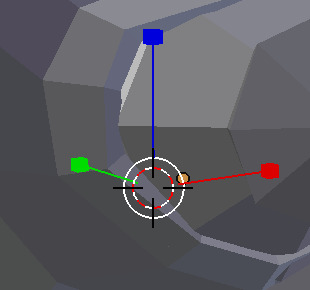
Viewport shadings:
Note: Not all shadings are compatible with edit mode!
Solid: Is basically your gray-scaled mesh with no textures or anything added! Just let’s you focus on the mesh (edit mode compatible)


Wireframe: Let’s you see the edges of your mesh but the faces will be invisible. This could be nice to see whether something is symmetric on spots that you wouldn’t be able to see in solid mode. You can also select vertices that you can’t select in solid mode! (Edit mode compatible)

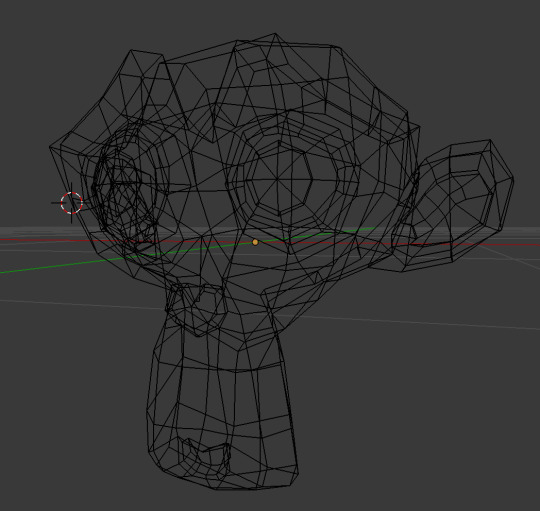
Texture: Makes you see the texture you applied on your UV map. To see how this will be helpful for TS3 meshing, click here: X
(Edit mode compatible)


Render: Sometimes useful to see how strong your specular map is. However for this, I’d recommend switching it to Cycle render. To read more about what the hell i’m talking about, here you go! x
And any tutorial on how to get it game-readyish: X


SHORTCUT INSTRUCTIONS:
Note: All these shortcuts will work in the UV map layout we’ll encounter later on. I’d also suggest copy pasting this list on a text editor so you don’t forget about them.
A: Will select everything Object mode (The view we’re in right now) And will select all the dots (vertices) In Edit mode.
B: Will let you select whatever you want with just dragging the mouse
C: Hey we made the alphabet here Is basically this brush selecting tool. Works great in Edit mode, but I rarely use it in object mode.
CTRL+Rightclick: (Does not work with the UV map layout) Will let you create this circle to select stuff!
TAB: Will let you switch back to edit mode or object mode!
L: (Will only work with Blender 2.70 or later) Stands for ‘Linked’. Will let you select parts of the mesh that are, well linked in a way. Works great with meshes with hard edges or hair meshes!
Shift+Right click: Is selecting one object (In object mode. In edit mode, you’ll be able to select one vertex at a time).
S: Stands for scaling.
S+X: Stands for scaling horizontally
S+Y: Stands for scaling vertically
R: Stands for rotating
G: Stands for grab n move!
G+Y: Stands for grab and moving it up and down
G+X: Stands for grabbing and moving it left and right
CTRL+J: Will join 2 separated ‘groups’ or ‘meshes’ together! Edit mode only!
Spacebar: If you can’t find a specific option, just search it! :)
Recommended settings for TS3:
Setting things up for the sims 3 could be a pain when you have no idea what the game works with and what-not. If you’re not really familiar with creating stuff for games in general, especially the sims 3, I’d definitely check this part out! :)
Right navigation side bar settings:
Note: Make sure that the following settings are being checked in Object mode NOT edit mode!
Location: This should always be on 0.00000. Reason why is because else your CC will be say, somewhere under your world when placing it in-game! Or super high in the sky! We don’t want that to happen, eh? ;)
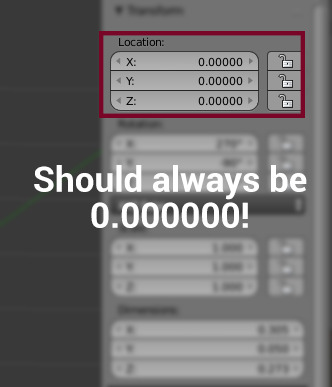
Scale: This one should always be set to 1.000. This is very important! If you scale them up, it will screw up your UV map and Blender will throw tons of errors. If you do want to scale something up, please do this in edit mode NOT Object mode!

TIP: Scared of accidentally exporting it with these values being not correct or just wanna be lazy/safe? Try ticking these slot thingies before meshing! :) You’ll love them!

3D Cursor: In object mode you always want the cursor to be on 0.0000. This will be helpful when adding an existing Blender mesh! :) If it’s not on the 0.0000, then this could cause issues too with uv mapping.
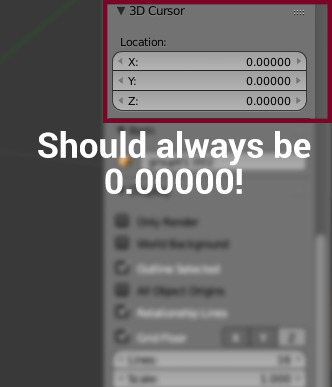
Shadings: There’s not that much that we need to take care of here, but there’s one VERY important box we have to tick, which is the ‘backface culling’. Reason why is, is that the way it will look like turned on is the way it will look like in-game. Turning it off will NOT fix it!
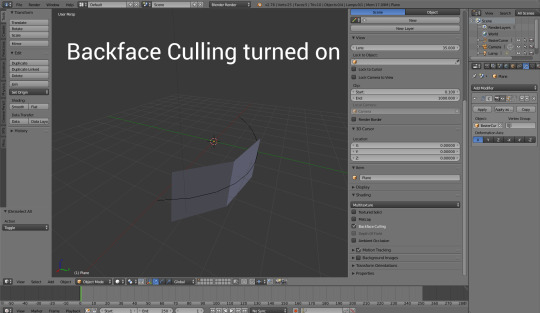
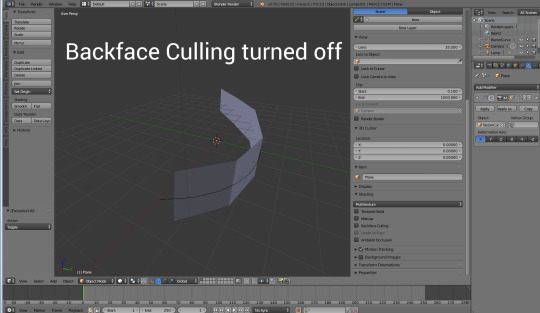
See how when turned on the back is invisible? This is how the plane will look in game if you don’t fix this. But... how *do* we fix it? Let’s go into edit mode!

1. We want to duplicate the mesh with Shift+D and then left click to confirm the duplication.

2. Then, we want to use the spacebar which stands for searching certain functionalities, type in ‘Flip normals’ and then press enter,

3. And there you go! Now the game won’t make them invisible from the back!
Left side bar navigation:
Shading: This option is only available in object mode. And is very helpful when you just imported a mesh but it doesn’t quite look right. Have a few examples!

Note: This option won’t just affect blender, it will also affect in-game.
Flat:
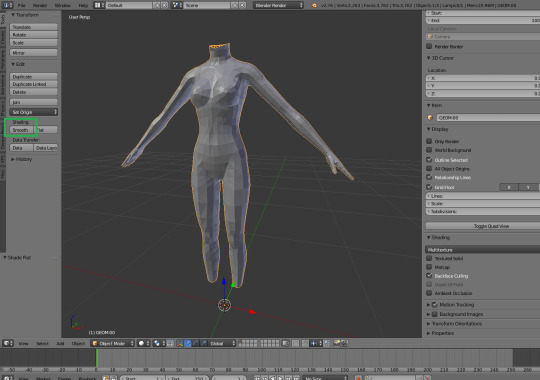
Smooth:

Now you think ‘why can’t it just smooth always?!’ well...
Smooth: Oh yuck! it’s 2005 all over again D:
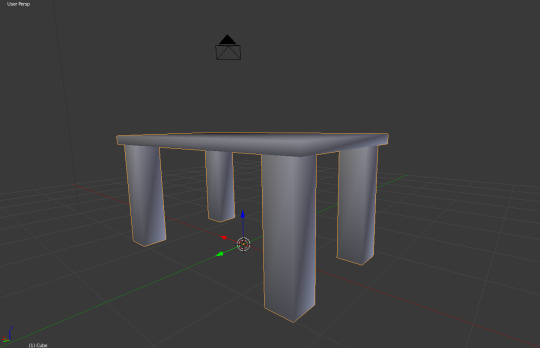
Flat: Yay! it’s table-y! :D

Don’t fancy them all being fully flat or smooth? Let’s get to the next tab...
Shadings/UV>Shadings: This is really helpful for when you’re working on complex meshes! Shoes for example, would probably need this or a specific furniture, or even hair! The most recommended way of doing this is by selecting a few faces and use either the ‘faces: smooth’ or ‘flat’ function
Note: Only shows up in edit mode!

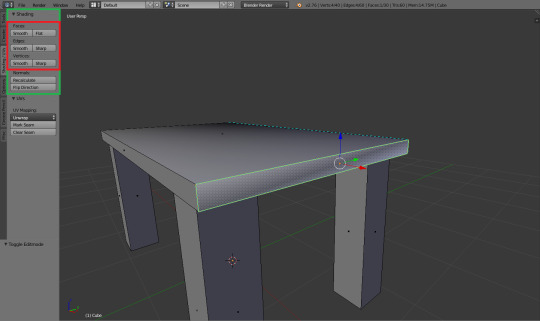
Exporting recommendations
When you’re sure you UV mapped it properly, and your mesh is ready to see the good ol’ milkshape to get it game-ready, the most recommended way of exporting it would be as a waterfront OBJ. OBJ is a really raw export function considered how it doesn’t support bones, which in this case is amazing! Since we don’t do anything with them in Blender when meshing stuff for ts3 :) BUT! There are some settings you want to have in order to export things successfully.
Let’s take a look at this thingy:

For exporting OBJ files:
Apply modifier
Include edges
Write normals
Include UVs
Objects as OBJ groups
Optional: Write materials (Basically your textures)
Scale: should be set to 1.00
Forward: -z Forward
Up: Y up

You can even save the setting by clicking on the + next to the ‘operator Presets’ and call it something like ‘ts3 export’ so you don’t have to keep selecting them :)
Helpful guides when you’re a noob!
Now this thing might be super duper long, but does not cover all the things you can do with it! I do recommend watching all or most of these links/videos in order to understand what the tutorials are about and what I’m doing.
NOTE: I occasionally will write down the shortcuts for specific functions but I WILL NOT explain it in my tutorials. They’re written for people with a basic knowledge for at least blender or their chosen 3D program.
Blender starters tutorials:
Interface explanation
Blender fundamentals
Beginner’s course
Awesome UV mapping tutorial
Model with curves
Customized bump maps
Simlicious:
Covering the basics in text
Info about normals
UV mapping to make things ts3 pattern-y good!
Me!:
Render only
Bake less pixelated textures
Fun stuff to look at and follow but optional:
Note: When following specific tutorials about cycle renders (Like making something translucent) These will NOT work in-game. Everything shown in render apart from the specular map, normal map and the diffuse map will NOT work in-game
Blender cloud: Is a really cool platform where you can basically watch whatever you want to gain knowledge on from the professionals! Which, is not your regular youtube videos ;) You won’t be disappointed!
https://cloud.blender.org/welcome
Blender free textures: Is a free online database where there are over 1500 free textures you can choose from, for non-commercial to commercial use, all for free! So no copyrighting involved!
https://cloud.blender.org/p/textures/
Blender today: Is kind of this awesome newspaper website. everyday you’ll get a new article, some artwork, others awesome tips to improve your work with Blender!
http://blender.today/p/
Jayanam: Has some great blender tutorials to maybe give you some ideas for your next meshing mission! :)
https://www.youtube.com/watch?v=icABMWGkOn4&list=PLboXykqtm8dydLQFk962346_TrAgzfMCF
Yan’s UV mapping tutorials: I learned a lot by just watcihng these videos! It sure is a recommended video to watch, but watch this one after you know how to UV map!
https://www.youtube.com/playlist?list=PLvPwLecDlWRD3F9lVD0ks_sdpxCgxgYm-
Hand-painted Sword by XRG81: Why this one? Well it did teach me the advanced ways of drawing on a texture map instead of just guessing in Photoshop if I did them write! :) And besides! It’s a really awesome way to avoid seams!
https://www.youtube.com/playlist?list=PLNHJ5gduZOiWXtbeiZZi3q082bclOHQY4
Tutor4u: Has tons of awesome tutorials on how to work with stuff in Blender!
742 notes
·
View notes